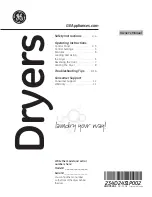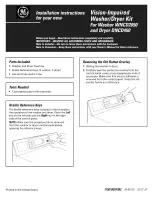
ПОСУДОМОЕЧНАЯ МАШИНА
DISHWASHER
ПОСУДОМОЕЧНАЯ МАШИНА
DISHWASHER
РУКОВОДСТВО ПО ЭКСПЛУАТАЦИИ
РУКОВОДСТВО ПО ЭКСПЛУАТАЦИИ
40
41
You should never let the rinse aid level be less than 1/4 full. As the rinse aid diminishes, the size of
the black dot on the rinse aid level indicator changes, as illustrated below.
WARNING! If the rinse aid is spilled, wipe it off with an absorbent cloth to prevent
excessive foaming at the next wash. Do not forget to close the tank cover in place before
closing the door.
Turn the rinse aid indicator dial to a number between 1 and 6. The higher
the number, the more rinse aids the dishwasher uses. If the dishes are not
drying properly or are spotted, adjust the dial to the next higher number
until your dishes are spot-free. Reduce it if there are sticky whitish stains
on your dishes or a bluish film on glassware or knife blades.
3. Detergent
The chemical ingredients that compose the detergent are necessary to remove, crush and dispense
all dirt out of the dishwasher. Most of the commercial quality detergents are suitable for this purpose.
Only use powder detergents in the tank before starting the wash cycle.
Cleaning tablets
Tablets of different brands dissolve in water at different rates. In this regard, when using short-term
washing programs, some tablets are not completely dissolved and can’t give a full effect. Therefore,
when using tablets, include long-term washing programs to ensure complete removal of detergent
residues.
Tank for detergent
The tank should be filled before each start of the wash cycle according to the instructions given
in the table of wash cycles. This dishwasher uses less detergent and rinse aid than conventional
dishwashers. As a rule, only one tablespoon of detergent is sufficient for normal washing (for heavy
dirt, more detergent is required). Load the detergent directly before turning on the dishwasher,
otherwise it may get wet and not completely dissolve.
2
3
1
NOTE:
• Be aware that depending on the soiling of water, setting may be different.
• Please observe the manufacturer’s recommendations on the detergent packaging.
WARNING! Use only detergent specifically made for dishwashers use.
Keep your detergent fresh and dry. Don’t put powdered detergent into the
dispenser until you are ready to wash dishes! Dishwasher detergent is
corrosive! Keep dishwasher detergent out of the reach of children.
LOADING THE BASKETS OF THE DISHWASHING MACHINE
Recommendations:
• Consider buying utensils which are identified as dishwasher-proof.
• For particular items, select a program with the lowest possible temperature.
• To prevent damage, do not take glass and cutlery out of the dishwasher immediately after the
program has ended.
For washing the following cutlery/dishes
Are not suitable
Are of limited suitability
1. Cutlery with wooden, horn china or mother-
of-pearl handles
2. Plastic items that are not heat resistant
3. Older cutlery with glued parts that are not
temperature resistant
4. Bonded cutlery items or dishes
5. Pewter or cooper items
6. Crystal glass
7. Steel items subject to rusting
8. Wooden platters
9. Items made from synthetic fibers
1. Some types of glasses can become dull after
a large number of washes
2. Silver and aluminum parts have a tendency
to discolor during washing
3. Glazed patterns may fade if machine washed
frequently
Important!
Scrape off any large amounts of leftover food. Soften remnants of burnt food
in pans. It is not necessary to rinse the dishes under running water. For best performance of
the dishwasher, follow these loading guidelines.









































